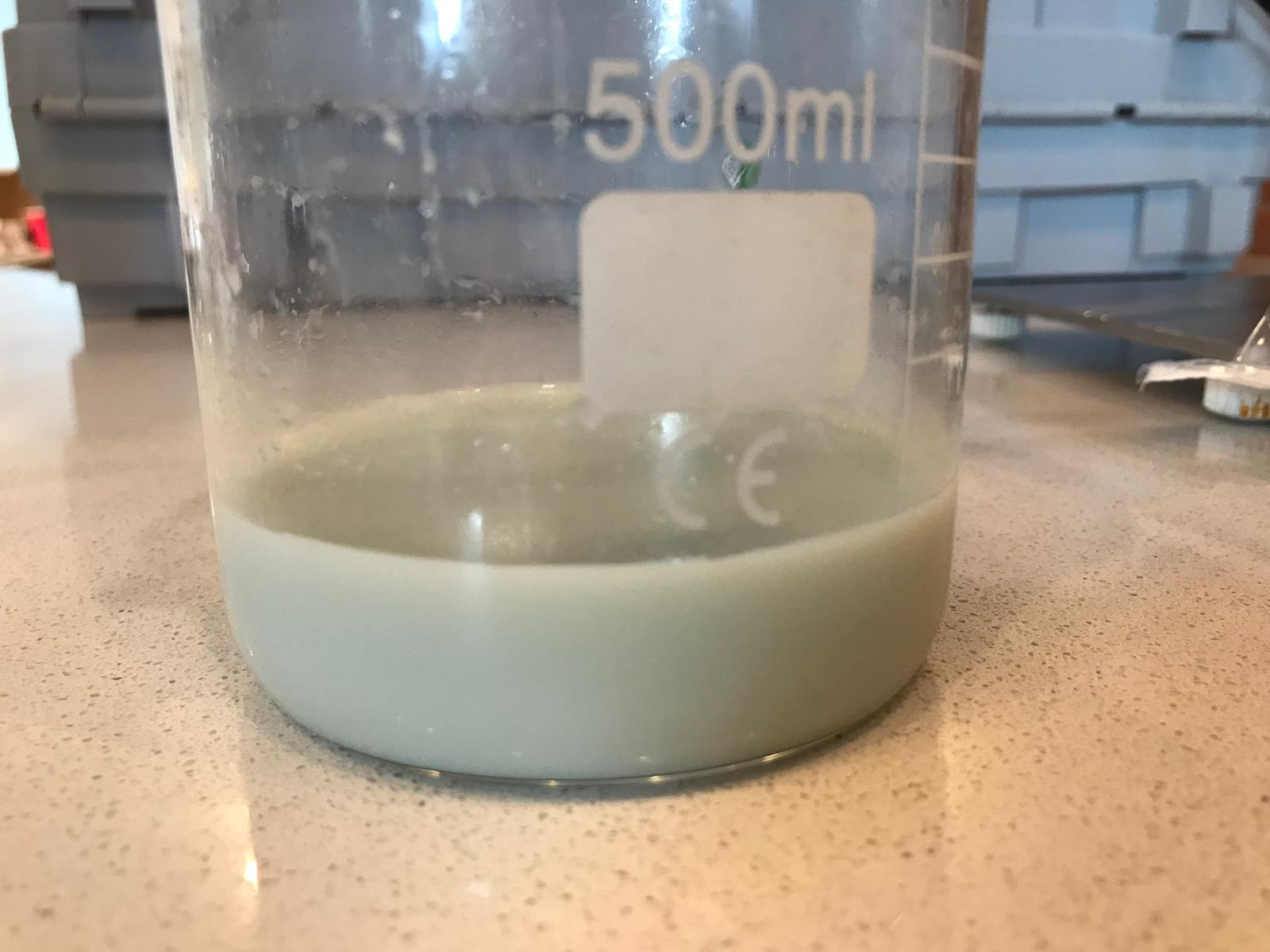That says that to be translucent, it must be 25% below all the visible light. That is it needs to be below 95nm, the smallest wavelength being the critical threshold. I mean even that picture you posted is still a little cloudy and it’s below 100 nm
Right! The key is translucent vs. milky. What I’m getting at is that if you have an emulsion that looks like the product on the left, it’s definitely below 250 nm because of light; if you have a product like what’s on the right, the particle size is >250. You can have a nanoemulsion that is translucent with MDS @ 200. I could still sterile filter that. When I try to filter the milky/cloudy emulsions through a .220 micron filter, they don’t move through it while the ones that look cloudier than the one on the left but still let light through filter no problem.
a LOT depends on your concentration. Also I would (did) play around with the ratios and can get translucency like that sample a but at a much lower concentration than I like to make.
Ok I see what you’re saying. But even that first picture you posted looks fairly translucent. Not as good as the polysorbate on the right but not nearly as bad as that example picture.
Oh, the first picture I posted was of a translucent nanoemulsion I made with polysorbate (left) and the one on the right was that diluted in water @ 50mg/12 oz. beverage. The one I posted earlier today was a translucent result at low oil loading with q-naturale as the emulsifier. The final image I posted was just from a research paper I found talking about translucense and particle size.
Sorry for any confusion!
If I could make all of my emulsions look like the polysorbate example (first picture), I’d be sooooo happy haha
Can you post pictures of the “bad” emulsions you made?
Yeah not great. How about when diluted?
I don’t have a photo but it looks pretty clear when diluted, maybe slightly turbid. The issue I’m worried about though is being able to sterile filter, makes things easy for stability and removing nano particles from the sonotrode.
is this just distillate and Q-naturell or are youa dding water also?
I don’t have Q-Naturell yet… I’m hoping I get a delivery this coming week.
I’ve made a solution using 4.6 ML of MCT CBD oil. - 1.53 ML PS80, 0.80 MG of Lecithin powder and 152 ml of tap water.
The taste was quite good and palatable - but it’s a milky liquid. After 3 days of leaving the liquid out in the open the liquid started turning blue/green.
Do you think that it’s bacteria and that a sterile filter would solve this issue?
Hey @TheGoodBud, all of my emulsions are oil in water. About 90% water and up to 10% oil+emulsifier. I do it with both isolate and distillate with success at low oil loading.
I’m not sure if that’s bacteria or what is happening, but a solution of that turbidity would probably not pass through a sterile filter anyway… try lowering your oil loading to 10 mg/mL (1 wt%) and start from there.
I’ve found this thread very interesting. I’m wondering if either of you have any thoughts on an emulsion with a higher alcohol content. Say in the 65% ABV, for incorporating both Cannabis Essential oils and extract? Most emulsifiers I’ve played with don’t work in Alcohol or at such a high ABV. They tend to have an oil slick appearance on the surface, and can get a little cloudy.
Eventually I would like to find a solution that be stable enough that you can add a few drops of the mixture to a glass of water and have it not separate or create the aforementioned oil slick on the waters surface).
I forgot to post this… Ingredion got back to me. I don’t fully understand these directions, do you understand what they mean by these ratios? This is supposed to be for a clear beverage.
Does QS to 100% mean add water to bring the total up to 100%? I.e. the 35 wt% q-naturale is only 14% surfactant and thus 86% water, so by weight that’s really actually 4.9% surfactant… so 30% of the water in the formulation is coming from q-naturale. So for 1 gram that’d be 350 mg q-naturale (49 mg saponin and 301 mg water), 500 mg oil, and then an additional 150 mg of water? That seems like WAY too high of oil loading, I think I have something wrong here…
Just guessing here
1L water.
1.5g Sodium Benzoate
3g Citric Acid
350ml Q-naturale
500ml of oil
That 50% oil is weird though
So you think the total solution volume would be about 1.85 liters? Which puts the oil by volume at like 27%…
The Ingredion literature does talk about the “rcp method” which has something to do with sufficient packing within the micelle, but I can’t find any literature on that besides that one reference ![]()
Yeah that’s my guess, but I would honestly do like 4 emulsions one at 150ml, 200ml, 250ml and 500ml of oil. I’m guessing the sweet spot is gonna be between 150ml and 250ml.
Where did u get your q-naturale, I want to try this now
I tried making a ethanol/oil solution first - and had similar experience to you.
I did no tice that when adding it to a surfactant that the mixing process went much quicker. I presume this is because the viscosity was more similar to water than to the thick oil.
What does the sodium benzoate and citric acid do?
@TheGoodBud they’re preservatives!
@Thetetraguy I just got it as a free sample from Ingredion. I’m fine with a 10 mg/mL (1 wt% oil) formulation, I just need to get translucent and consistent!





